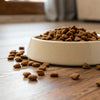Understanding Why Doesn’t My Dog Like Dry Food? Tips to Encourage Healthy Eating Habits
- Houndsy
Table of Contents
- Introduction
- Common Medical Reasons for Refusing Dry Food
- Behavioral Reasons for Picky Eating
- Practical Solutions to Encourage Eating
- The Role of Houndsy in Elevating the Feeding Experience
- Conclusion
Introduction
Have you ever watched your beloved canine companion turn up their nose at their bowl of dry food, leaving you puzzled and concerned? You’re not alone. According to a survey by the American Pet Products Association, over 60% of dog owners have experienced their dogs refusing to eat dry kibble at some point. Understanding the reasons behind this behavior is crucial for ensuring your furry friend maintains a healthy diet.
In this blog post, we will explore the various reasons why dogs might reject dry food, from medical issues to behavioral quirks. We’ll also provide actionable tips to encourage your dog to embrace their dry kibble with enthusiasm. Our aim is to empower you, as a pet owner, to enhance your dog’s feeding experience, making it both enjoyable and nutritious.
We will cover the following aspects:
- The common medical and behavioral reasons dogs refuse dry food
- Practical solutions to encourage your dog to eat
- The importance of meal presentation and feeding routines
- How Houndsy’s innovative products, like our Kibble Dispenser, can simplify the feeding process
By the end of this article, you’ll have a comprehensive understanding of why your dog might not be eating dry food and how to resolve this issue effectively.
Common Medical Reasons for Refusing Dry Food
1. Dental Issues
Just like humans, dogs can suffer from dental problems that make it painful to chew their food. Conditions such as gum disease, tooth decay, or broken teeth can lead to a reluctance to eat dry kibble. If you notice your dog avoiding food and possibly showing signs of discomfort, a visit to the vet is essential.
2. Gastrointestinal Problems
If your dog has an upset stomach, they may avoid dry food in favor of more palatable options. This could be due to eating something they shouldn’t have, stress, or underlying health issues like pancreatitis. If your dog is also exhibiting symptoms like vomiting or diarrhea, seek veterinary care promptly.
3. Age-Related Changes
As dogs age, their sense of smell and taste may diminish, making dry food less appealing. Additionally, older dogs may experience joint pain, making it uncomfortable to eat from a low bowl. Using raised feeding stations and ensuring the food is appealing can help in these cases.
4. Nausea
Nausea can be triggered by various factors, including changes in diet, stress, or illness. If your dog is showing signs of nausea, such as drooling or lethargy, it’s important to consult with your veterinarian.
Behavioral Reasons for Picky Eating
1. Picky Eaters
Some dogs are simply more finicky than others. They may have developed preferences for certain types of food or flavors, leading them to reject dry kibble altogether. This behavior can often be reinforced when owners give in and provide treats or wet food instead.
2. Stress and Anxiety
Dogs are sensitive creatures, and changes in their environment or routine can lead to stress, which may manifest as a decreased appetite. If your dog seems anxious or stressed, consider providing a calm feeding environment and maintaining a consistent routine.
3. Food Fatigue
Just like humans, dogs can grow tired of eating the same food day in and day out. This phenomenon, known as "kibble fatigue," can lead to decreased interest in their meals. Rotating flavors or incorporating toppers can make meals more exciting.
4. Poor Feeding Practices
Sometimes, the way we present food can affect a dog’s willingness to eat. Factors such as the bowl’s material, cleanliness, and placement can influence their dining experience. For example, a bowl that slides around or has an unpleasant odor may deter your dog from eating.
Practical Solutions to Encourage Eating
1. Check the Food Quality
Ensure that the dry food you’re offering is fresh and high-quality. Expired or low-nutrient food can lead to rejection. If your dog consistently refuses their current brand, it may be time to switch to a higher quality option.
2. Make Food More Appealing
Consider enhancing the flavor and aroma of dry food by adding warm water or low-sodium broth. This can make the food smell more enticing and easier to chew. Additionally, you can add healthy toppers like plain yogurt, boiled chicken, or vegetables to make the meal more appetizing.
3. Create a Comfortable Feeding Environment
Ensure that your dog’s feeding area is quiet and free from distractions. A clean bowl that’s appropriately sized for your dog can enhance their dining experience. If your dog has joint pain, opt for a raised bowl to make mealtime easier.
4. Establish a Feeding Routine
Dogs thrive on routine, so try to feed your dog at the same times each day. Remove uneaten food after 15-20 minutes to encourage your dog to eat when food is available. This strategy can help regulate their appetite.
5. Introduce Puzzle Feeders
To make mealtime more engaging, consider using puzzle feeders that require your dog to work for their food. This can stimulate their natural instincts and make eating more enjoyable.
The Role of Houndsy in Elevating the Feeding Experience
At Houndsy, we understand the challenges pet owners face when it comes to feeding their dogs. That’s why we designed the Houndsy Kibble Dispenser—a stylish and practical solution that simplifies the feeding process.
Features of the Houndsy Kibble Dispenser
- Convenience: Our dispenser features a convenient crank at standing height, eliminating the need for bending and making it easier for you to serve meals without strain.
- Perfect Portions: With our dispenser, you can serve perfect portions every time, ensuring your dog gets the right amount of food without the mess.
- Aesthetic Design: The mid-century modern design complements your home decor, making it a beautiful addition to your living space.
- Large Capacity: With a storage capacity of 25-30 lbs, it minimizes the frequency of refills, allowing you to spend more quality time with your pup.
- Safety Features: The BPA-free liner keeps food fresh, and the auto-locking mechanism prevents accidental dispensing by curious pets or toddlers.
By investing in the Houndsy Kibble Dispenser, you not only enhance your dog’s feeding ritual but also elevate your overall dog care experience. Discover more about our innovative product here.
Conclusion
Understanding why your dog doesn’t like dry food is essential for their health and well-being. By recognizing the potential medical and behavioral reasons behind their reluctance, you can take actionable steps to encourage a more balanced diet. Whether it’s through improving the quality of their food, enhancing their mealtime experience, or utilizing innovative products like the Houndsy Kibble Dispenser, you can ensure your furry friend enjoys their meals.
If you find that these strategies don’t lead to improvement, it’s crucial to consult your veterinarian to rule out any underlying health issues. Remember, a happy and healthy dog is a well-fed dog!
FAQ
Why does my dog refuse to eat dry food but eats treats?
This behavior could indicate that your dog is simply a picky eater or that they prefer the taste and texture of treats over dry kibble. It’s essential to monitor their overall diet and try different food options if they consistently refuse dry food.
What can I do if my dog is not eating for more than a day?
If your dog hasn’t eaten for more than 24 hours, it’s important to consult with your veterinarian. Loss of appetite can be a sign of health issues that require professional attention.
How can I tell if my dog has dental problems?
Signs of dental problems in dogs include bad breath, difficulty eating, pawing at their mouth, and visible tartar buildup. If you notice any of these signs, it’s best to have your dog examined by a vet.
What is the best way to transition my dog to a new dry food?
To transition your dog to a new dry food, gradually mix the new food with their current food over a week. Start with a small amount of the new food and gradually increase it while decreasing the old food to avoid digestive upset.
Can I mix wet food with dry food to entice my dog?
Yes, mixing wet food with dry kibble can enhance the flavor and aroma, making it more appealing to your dog. Just be sure to choose high-quality wet food without added fillers or preservatives.
By implementing these tips and understanding your dog’s preferences, you can create a more enjoyable feeding experience for both you and your furry friend. Don’t forget to explore how the Houndsy Kibble Dispenser can transform your feeding routine for the better!












